• Which players are most effective against press, single coverage, zone coverage, and more: Highlighting the top FBS wide receivers throughout their careers in key receiving categories.
• Surprise! Marvin Harrison Jr. is effective regardless of the situation: The top-ranked wide receiver on the PFF big board shines through in multiple key situations.
• Draft and trade for yourself: Try PFF's Mock Draft Simulator — trade picks and players and mock for your favorite NFL team.
Estimated Reading Time: 9 minutes
Click here for more draft tools:
2024 Mock Draft Simulator | 2024 Big Board | 2024 Draft Guide
2024 Player Profiles | 2024 Mock Drafts | NCAA Premium Stats
The 2024 NFL Draft gets closer by the day, and there can never be enough data to pore over when it comes to evaluating prospects. After focusing on the running backs, this piece will focus on the top wide receiver prospects in this year’s draft and how they performed in key situations.
This piece will focus on a lot of metrics that are not readily available through PFF Premium Stats in order to give an exclusive in-depth breakdown of production that can’t be found anywhere else.
- Only FBS wide receivers will be included in this analysis.
- Yards per route run (YPRR) represents the amount of receiving yards per route run within each specific situation.
- The percentage of career receiving yards and touchdowns represents the amount of yardage and touchdowns that each wide receiver posted within each specific situation relative to the amount of total yardage and touchdowns for their career.
- Targets per route run is how many times a wide receiver was targeted on the routes run within each specific situation.
- Yards per target are the amount of receiving yards a wide receiver posted per the number of times they were targeted within each specific situation.
- 1DTD rate is the number of times a wide receiver caught a pass that went for a first down or touchdown per route run within each specific situation.
Overall Career Receiving Numbers

Starting with the basics, this is an overview of how each FBS wide receiver performed in the metrics that will be covered for their entire college career across all situations.
- Marvin Harrison Jr. is the clear yards per route run leader for this class, posting a dominant target rate and elite first down and touchdown efficiency throughout his college career.
- Malik Nabers isn’t far behind in terms of career production and efficiency on a per-route basis while ranking second in this class in yards per target behind Alabama’s Jermaine Burton.
- Washington’s Rome Odunze — the other potential top-10 pick in this year’s draft — ranks fourth in career receiving yards in this class and while his YPRR total isn’t quite as strong as Harrison or Nabers, the context around that total number makes it better than it seems, as highlighted in our personnel-adjusted YPRR data study.
Career numbers versus single coverage
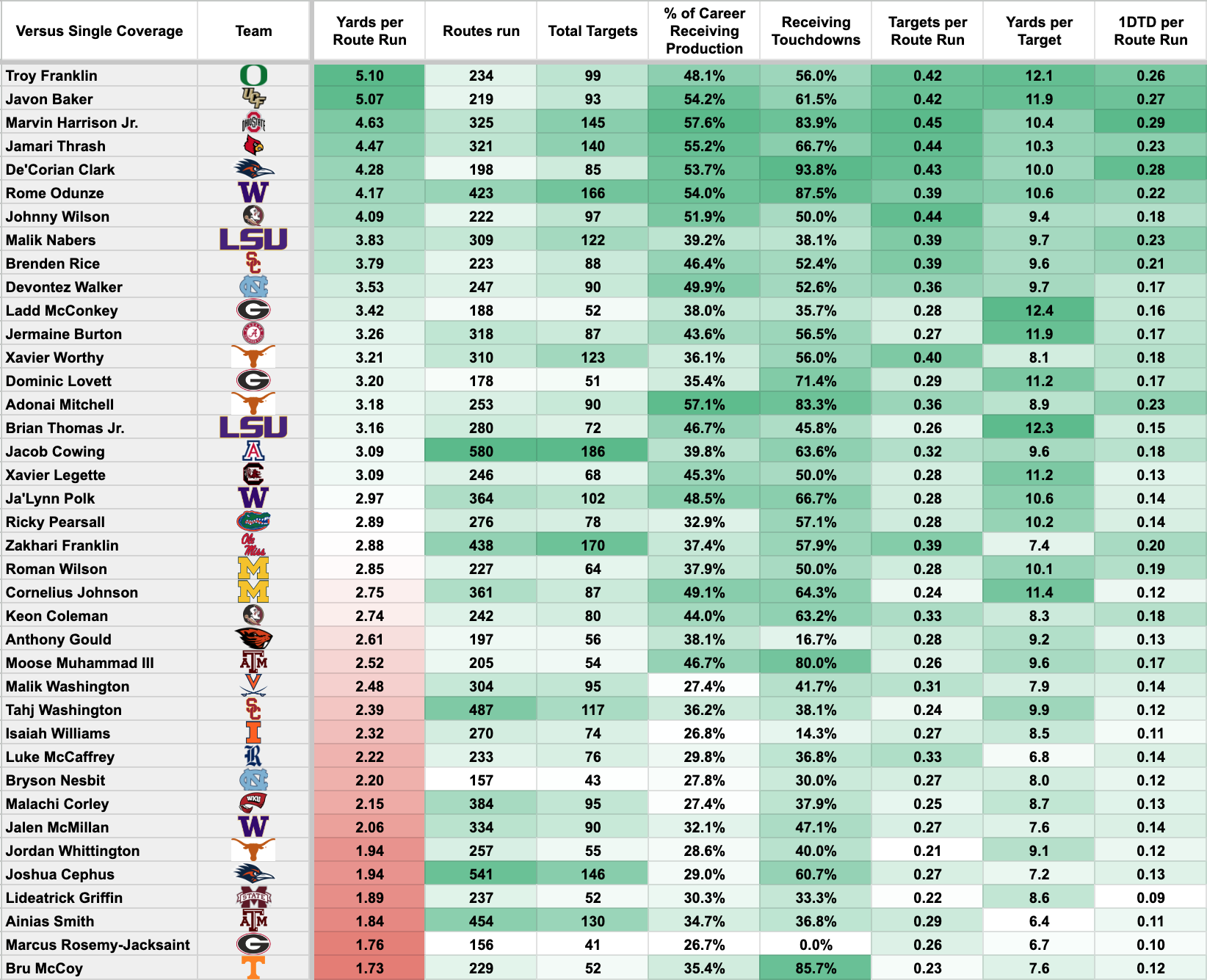
How wide receivers perform against single coverage simply highlights the player’s success rate going one-on-one against defensive backs in man coverage. This is especially important for outside wide receivers who face single coverage more often than those who align in the slot.
- Oregon’s Troy Franklin owns not only the best YPRR total in this year’s class but also one of the highest marks in recent years among wide receivers with at least 90 targets. He ranks fourth among qualifying wide receivers since 2019 behind only DeVonta Smith (5.95), Tee Higgins (5.32) and Ja’Marr Chase (5.25).
- UCF’s Javon Baker is also a standout in YPRR against single coverage operating as a primary outside receiver and leading the team in receiving yards in each of the past two years after transferring from Alabama. Baker’s production and efficiency translated to a top-four first down/touchdown rate and yards per target average against single coverage as well.
- Harrison appears near the top once again, ranking third in YPRR versus single coverage in this year’s class while accounting for the highest percentage (57.6%) of his receiving production against single coverage.
Career numbers versus zone coverage
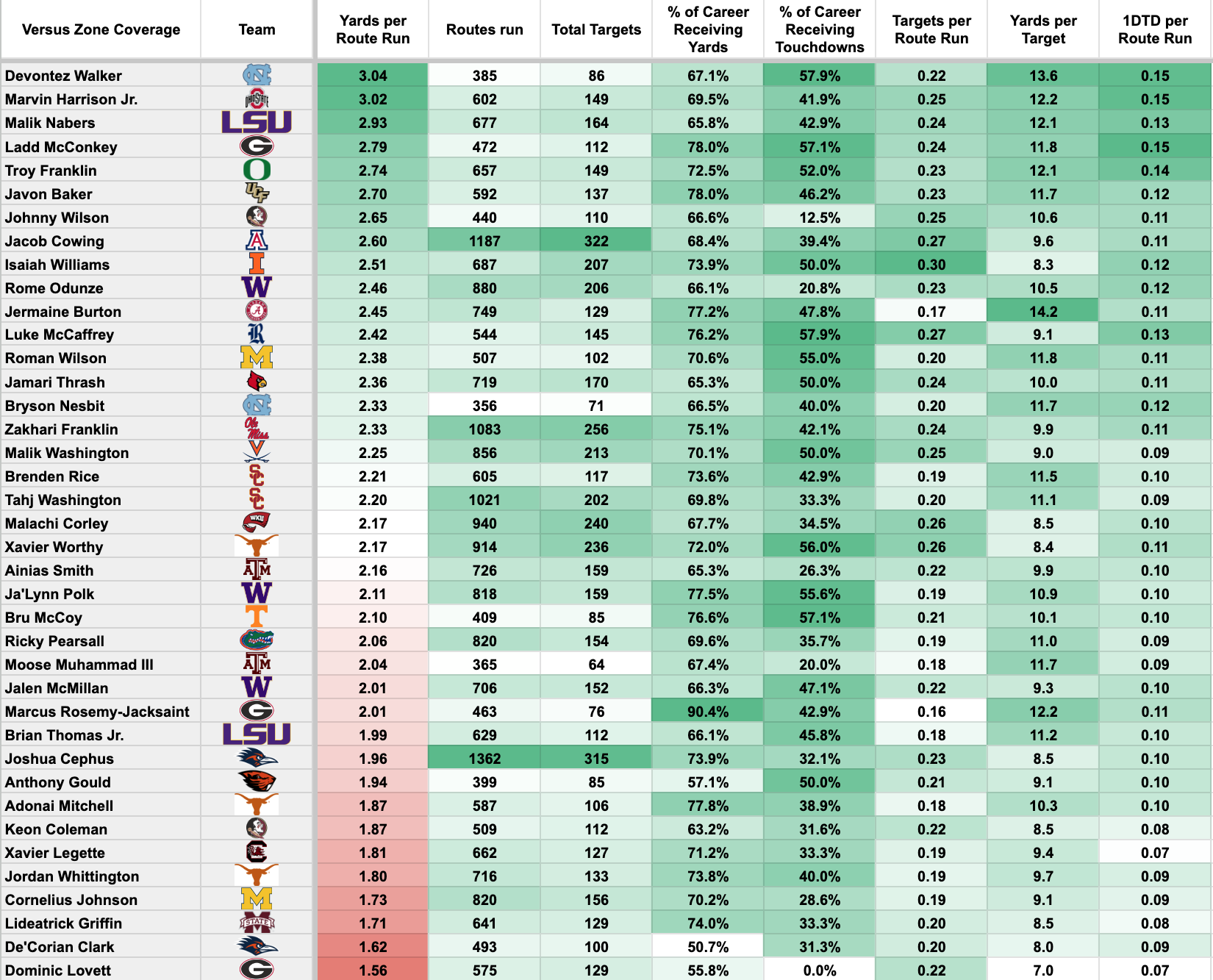
Zone coverage is the most common form of coverage scheme in college football as well as the NFL. Having a strong feel for zone coverage and knowing how to take advantage of the holes within those coverages is a translatable trait when projecting to the next level as well.
- A lot of the top names repeat here as YPRR leaders against zone coverage between Harrison, Nabers and Franklin. North Carolina’s Devontez Walker leads the class in YPRR versus zone, though he has one of the lowest sample sizes of routes run for the group as well.
- Georgia’s Ladd McConkey tied for the best first down/touchdown rate in this class while posting a top-three percentage of yardage and touchdowns against zone coverage as well. McConkey projects as a slot receiver in the NFL, so it is particularly encouraging that his production metrics against zone coverage are among the best in this class.
Career numbers versus press coverage
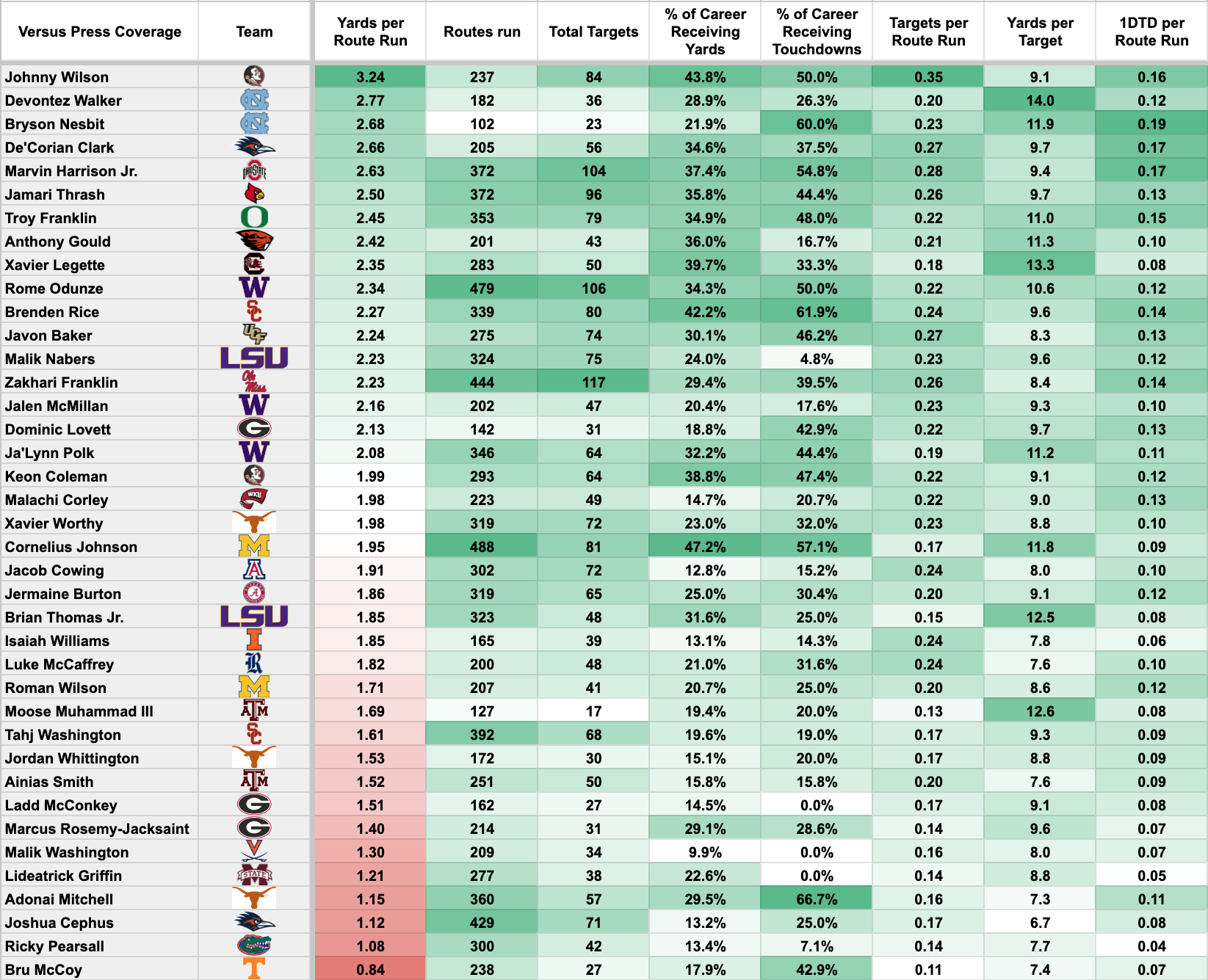
Press coverage involves a defender playing up on the line of scrimmage directly in front of the wide receiver, often with the intent to get hands on the receiver and create legal contact within the first five yards to jam up their release and throw them off their intended routes. This section highlights the receivers who have success against this tactic, as they are able to fight through the contact and still come up with targets, yardage and efficiency.
- The biggest wide receiver in this year’s draft class at 6-foot-7 and 237 pounds, Johnny Wilson, could not be stopped against press coverage, posting far and away the top YPRR figure in the class in these situations. It was evident that FSU looked to take advantage of these matchups as he also earned the highest targets per route run figure.
- Similarly, North Carolina’s Bryson Nesbit was also a force against press coverage, utilizing his size at 6-foot-5 and 235-pounds to deliver the best first down/touchdown rate of the class as well, although on a smaller sample size.
- Some lighter wide receivers near the top performers in Jamari Thrash and Troy Franklin are both under 190 pounds yet saw a large sample of work against press with encouraging metrics to support their “sleeper” status in this year’s class, as highlighted here.
Career red-zone production
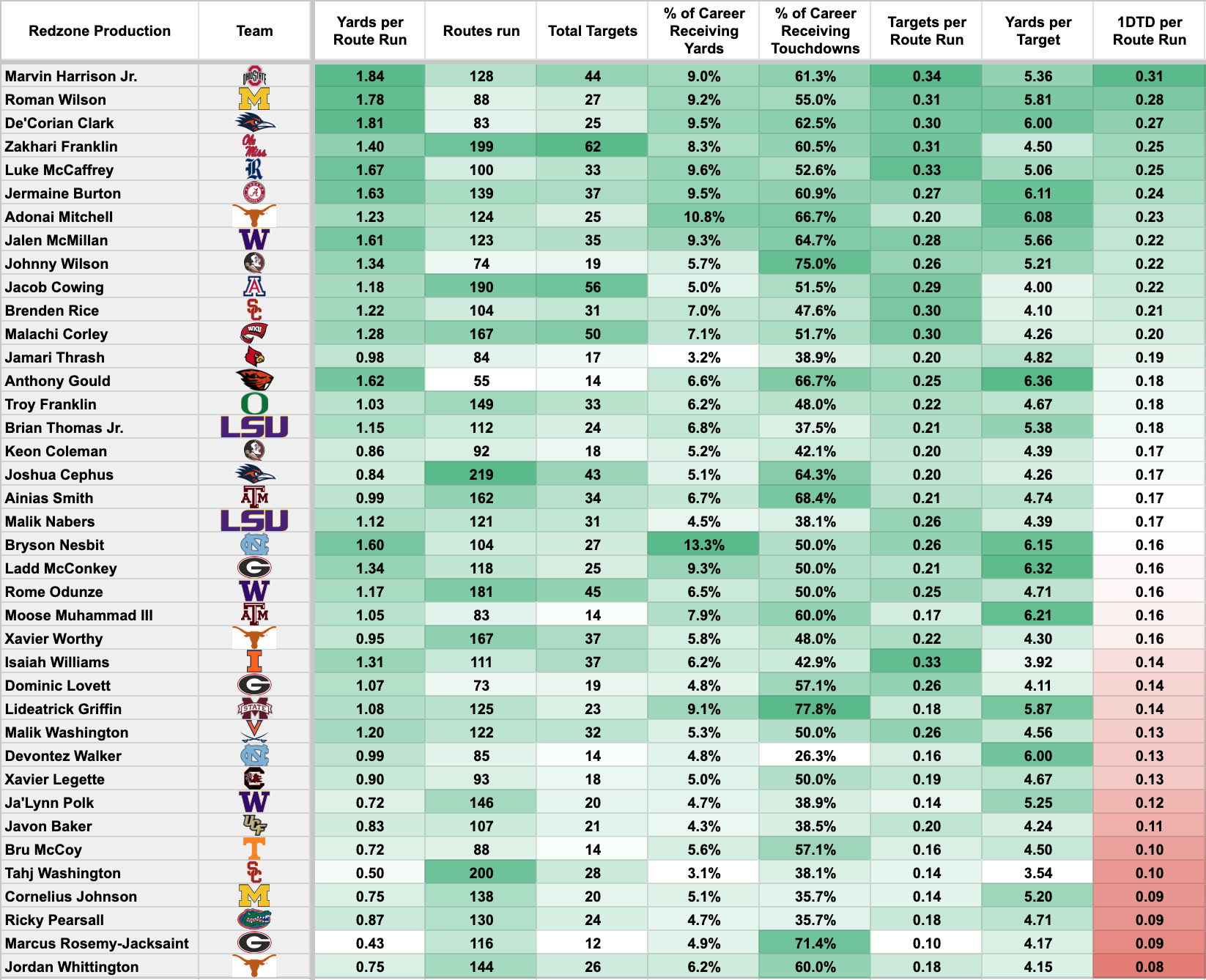
Red-zone usage and production are often associated with touchdowns, which translates to stronger fantasy performances.
- Success in the red zone should mostly be measured by first down/touchdown rate, and Marvin Harrison Jr. leads the way in that regard as well as yards per route run. He was also targeted at a higher rate in the red zone than any other player in this class, showcasing how much his team (rightfully) viewed him as an offensive weapon and their best chance to score touchdowns.
- Michigan’s Roman Wilson also had a high success rate in the red zone, delivering the second-highest first down/touchdown rate of the class, making for an impressive success rate despite being just a one-year starter.
Career screen production
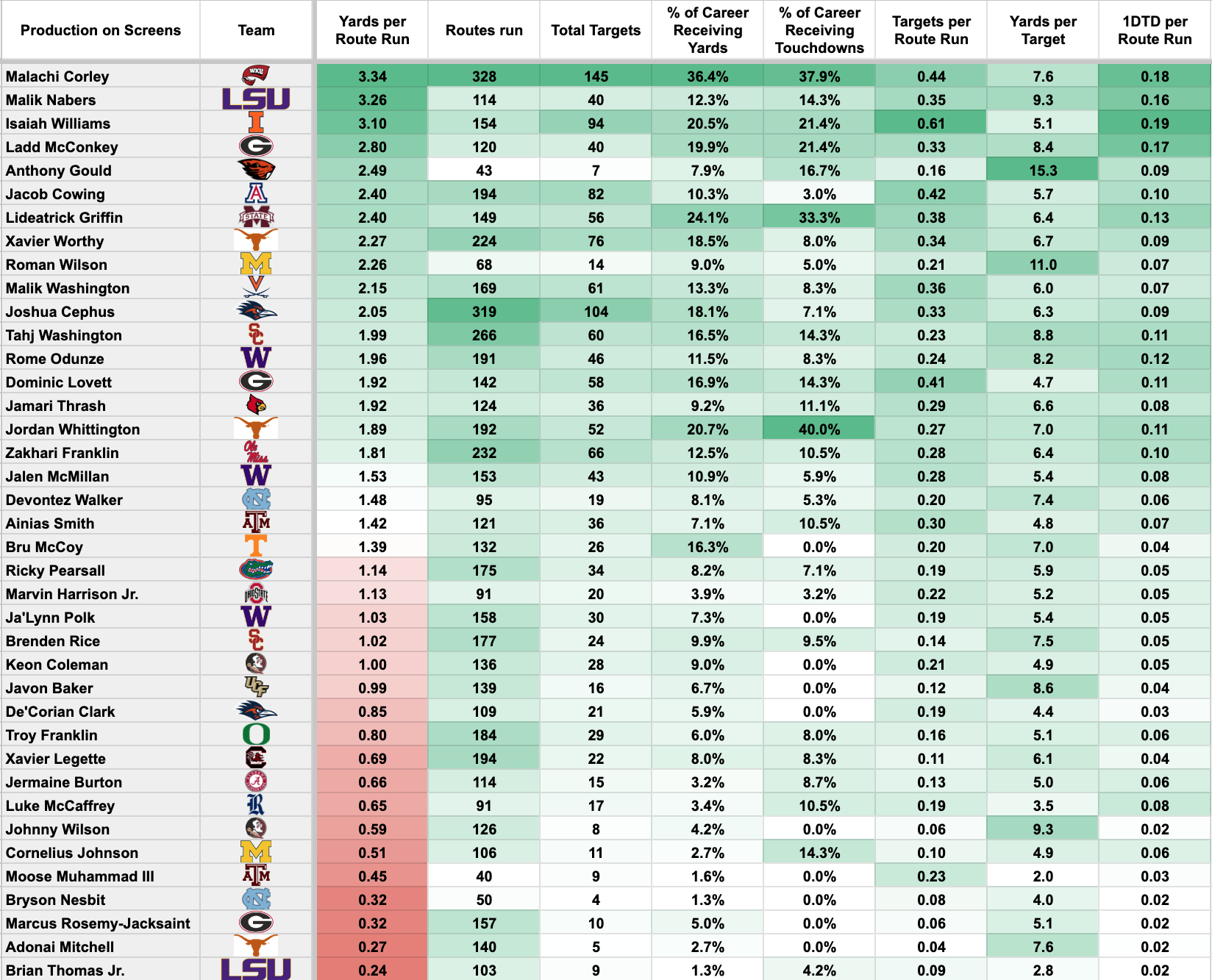
Understanding how much production receivers have on screen plays and how much usage they have in that regard helps contextualize their overall production in order to get a better understanding of what their true strengths tend to be.
- Western Kentucky’s Malachi Corley is the perfect example of a player whose overall production was propped up by screen plays, as 36.4% — the highest percentage of the class — came from screens. With screens being high percentage completions and typically an easier way to rack up yardage with blockers working in front of the receiver, this much usage in that regard can be viewed as a red flag when translating to the NFL.
- Malik Nabers is a better example of a player who has high-end success when being utilized on screen passes while not being overly reliant on those easy completions to produce, as only 12.3% of his receiving yardage came from screen passes.
Career deep ball production
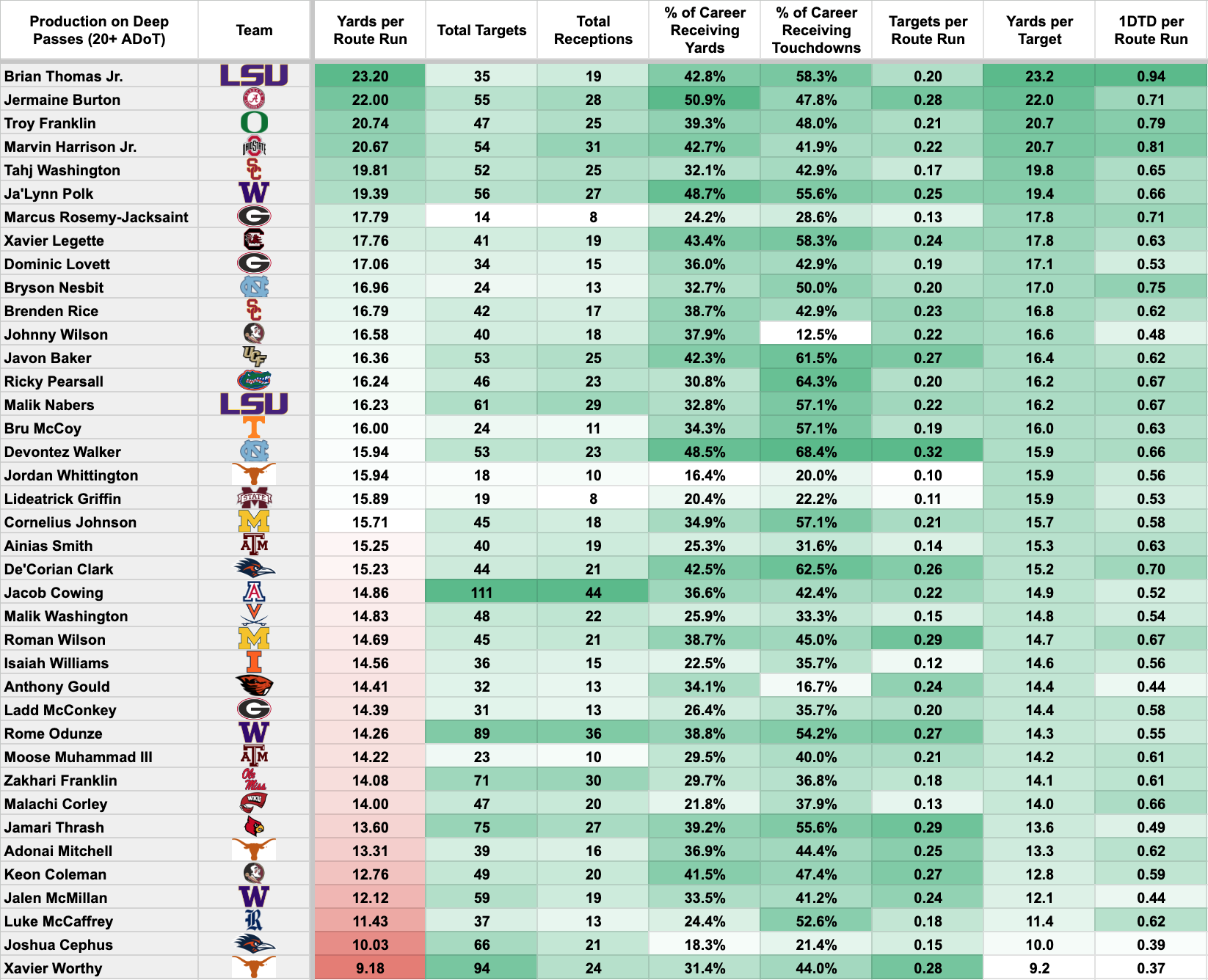
Highlighting each FBS wide receiver's usage on deep throws, as well as how often they’re used in that regard is a good way to highlight a key strength that results in high-value plays both for fantasy and for their respective teams.
- LSU’s Brian Thomas delivered the highest YPRR total for this entire class on throws 20-plus yards downfield, which ultimately resulted in the highest yards per target and highest first down/touchdown rate for the class as well. Thomas’ route tree indicates that he was primarily asked to run these deep routes more than anything else, so it’s encouraging to see that he was so effective when doing so.
- Alabama’s Jermaine Burton also had significant success on deep passes, which is why he led the entire class in yards per target as a whole. He is also the lone FBS wide receiver in this class to have more than half of his total receiving yardage come from passes 20-plus yards downfield. Since transferring to Alabama in 2022, just over 26% of Burton’s routes were go routes — far and away his most commonly run route.
Career late down production
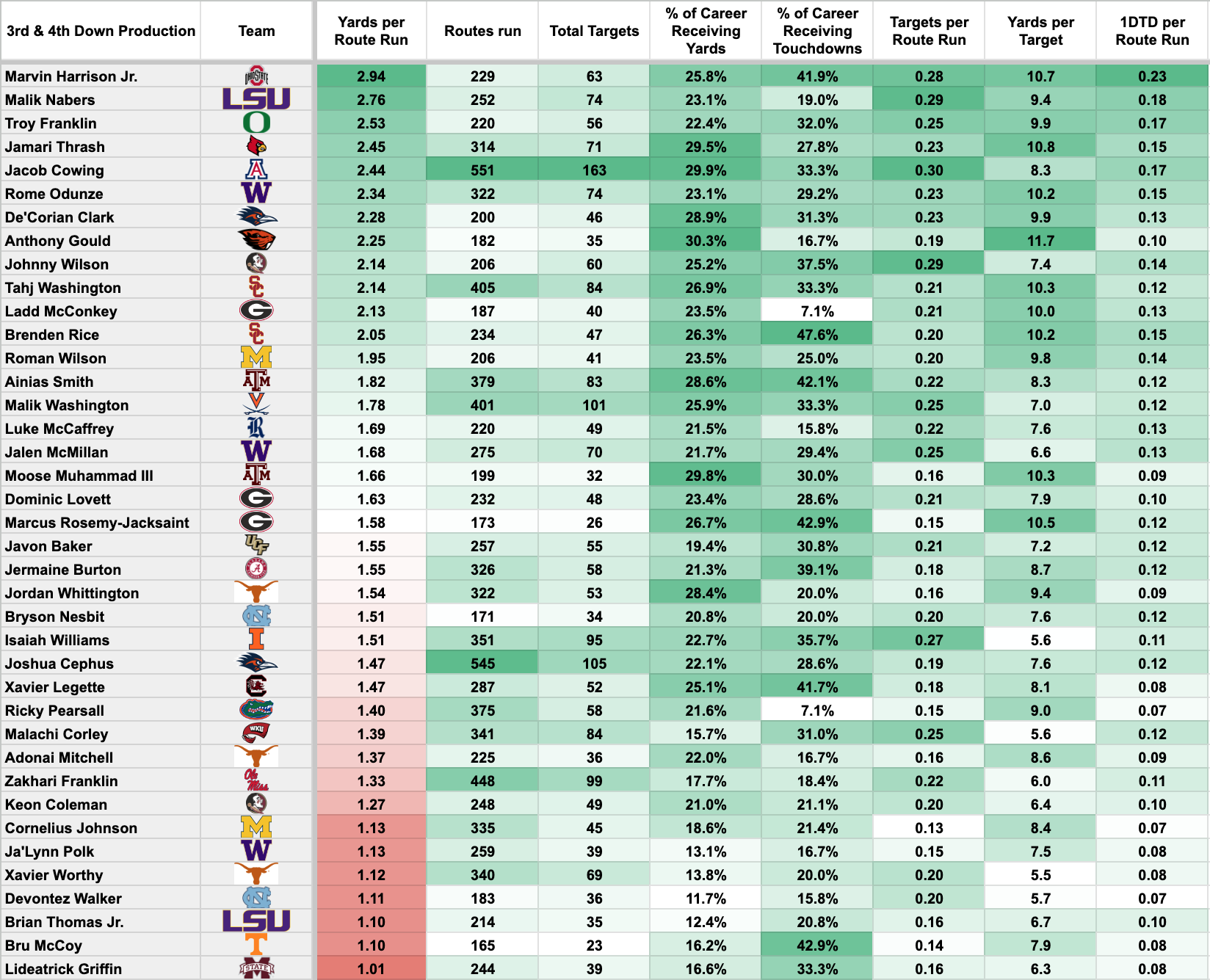
Lastly, focusing on the receivers who delivered when their teams needed them most, on crucial late downs. Getting targets in these situations and coming up clutch to convert on third and/or fourth down can be a positive indicator of the player’s teams trusted the most in each situation and who stepped up to deliver.
- Surprising nobody, Harrison Jr. leads the way in YPRR and first down/touchdown per route run. There really aren’t any questions at this point regarding his production profile and it’s why he is considered the top receiver in this draft.
- Malik Nabers comes in right behind Harrison Jr. in YPRR, as usual, while earning the second-highest targets per route rate in this class. Partly due to LSU’s heavy reliance on Nabers on key downs, Thomas Jr. became one of the most ineffective receivers in these situations.
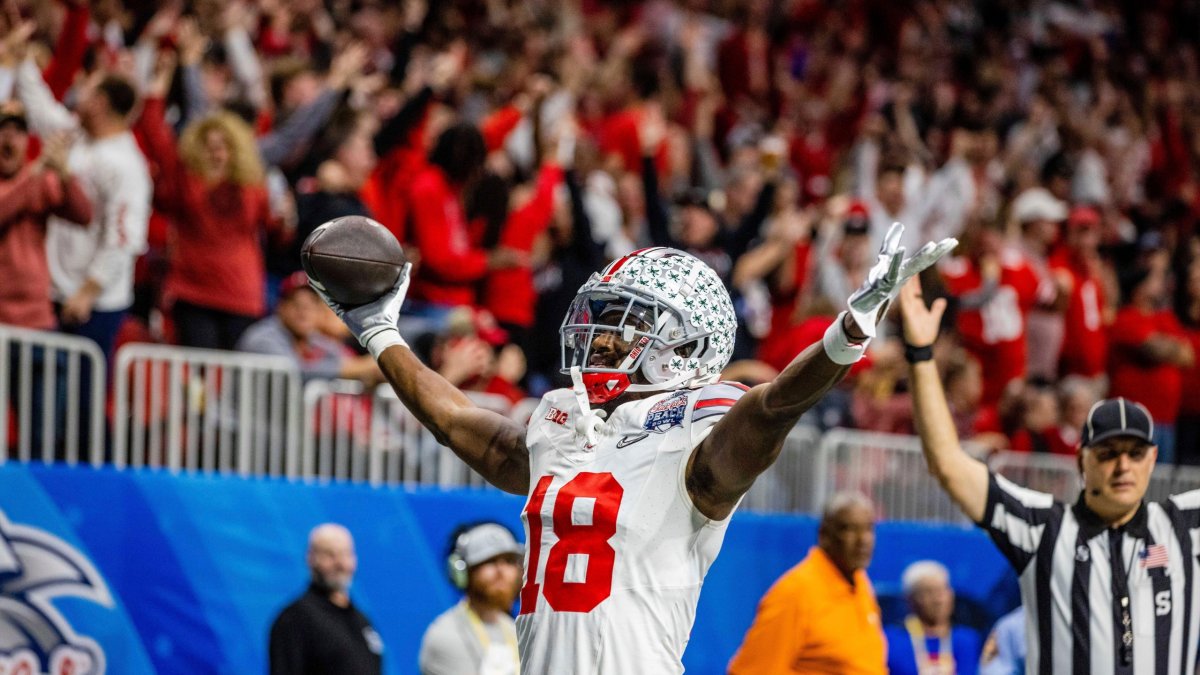



 © 2025 PFF - all rights reserved.
© 2025 PFF - all rights reserved.